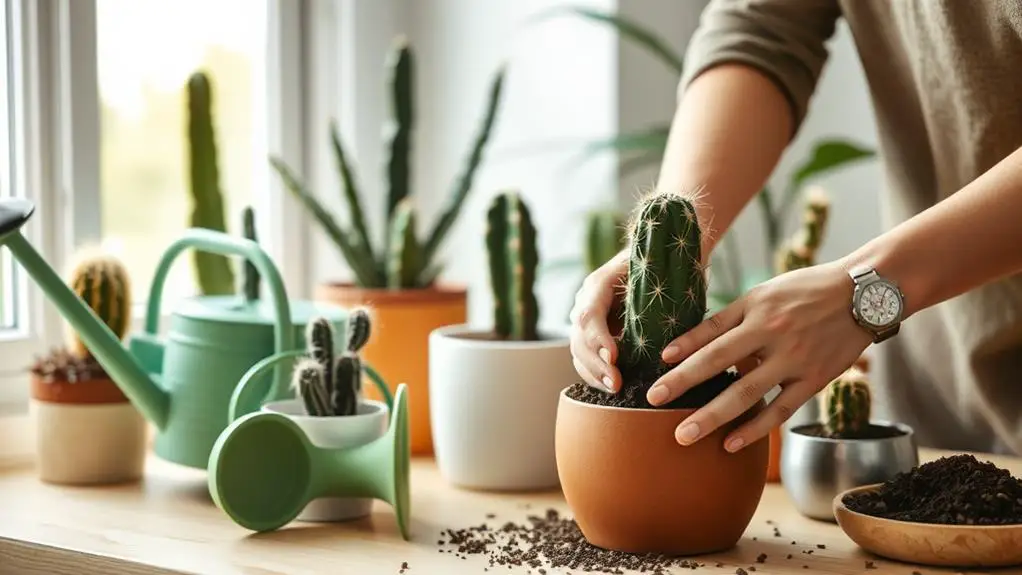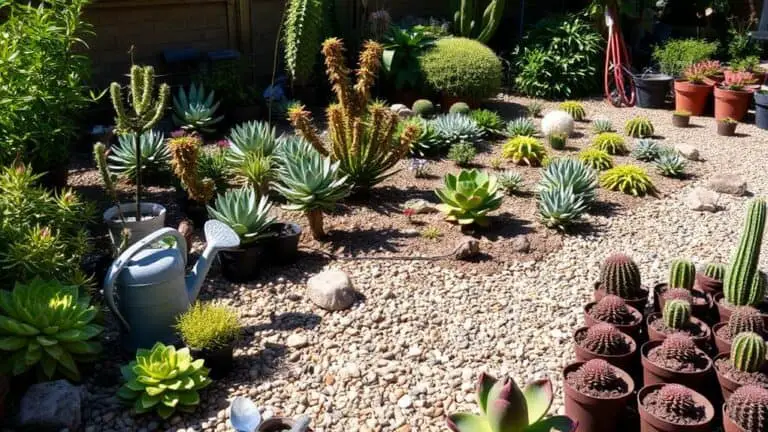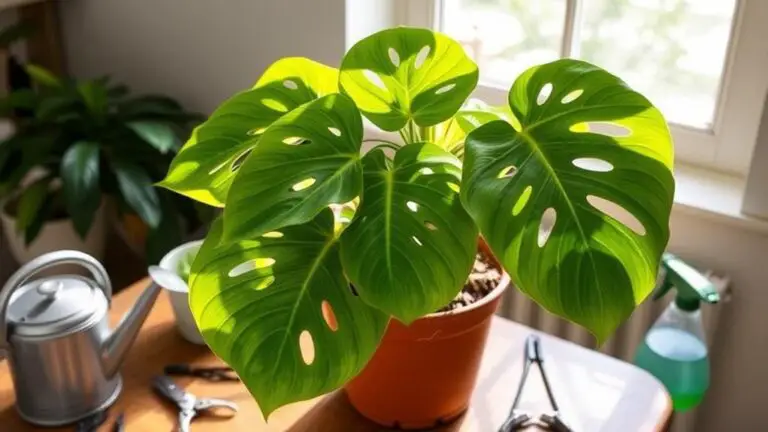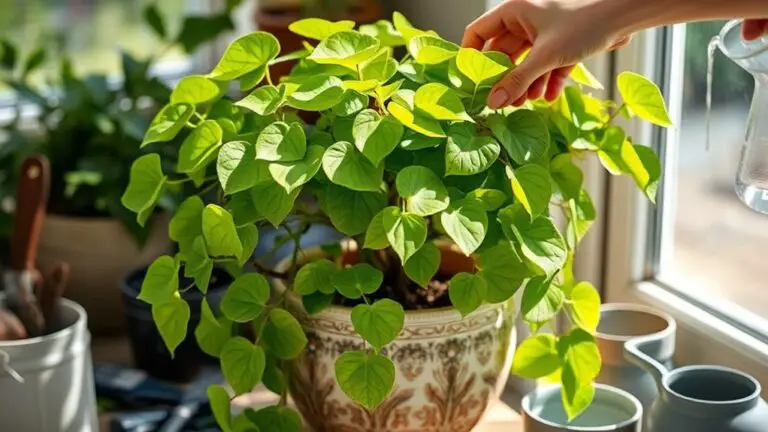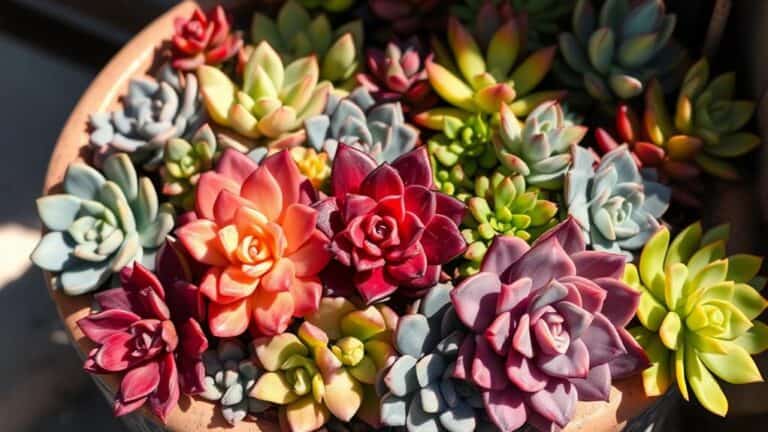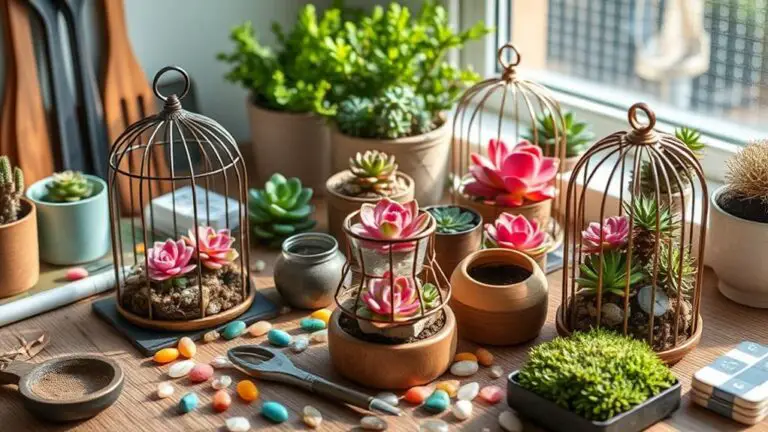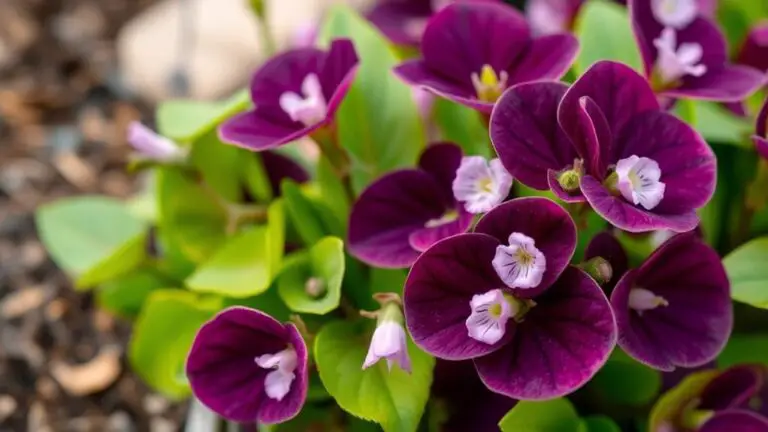7 Easy Steps to Grow Cactus Indoors
Growing cactus indoors might seem intimidating at first, but you'll find it's quite manageable with the right approach. Start by choosing resilient varieties that thrive in an indoor environment. Once you've picked your cactus, the key is to guarantee they receive sufficient light, ideally around six hours of bright light daily. Watering can be tricky; you'll need to let the soil dry completely between sessions to avoid root rot. But that's just the beginning—there are a few other vital steps that will make your indoor cactus garden flourish. Curious about the rest? Let's get into the details.
Choose the Right Cactus
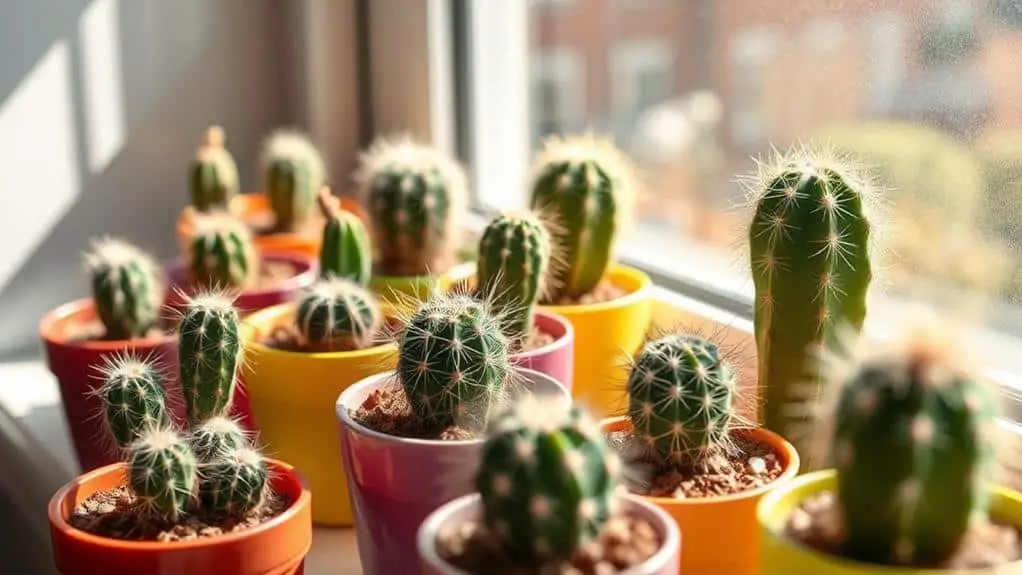
When selecting the right cactus for indoor growth, focus on choosing resilient desert cacti that thrive in dry conditions. These plants are perfect indoor companions because they can withstand various indoor environments.
Look for cacti that are healthy, showing vibrant colors and firm structures. Avoid any plants with discoloration or soft spots, which could indicate disease or damage.
For areas with low light, consider cacti like the Blue Candle or Angel Wing. These types are better suited for dimly lit spaces compared to those needing bright light. If you have brighter spots in your home, you can explore other options.
Always choose cacti sold in pots with drainage holes. This feature is vital for preventing overwatering, a common issue with indoor plants. Overwatering can lead to root rot, so drainage holes help keep your cactus healthy.
Popular indoor cacti such as Pincushion, Rainbow, and Old Lady are excellent choices. They've unique shapes and, with the right care, they can even bloom beautifully.
Provide Adequate Light
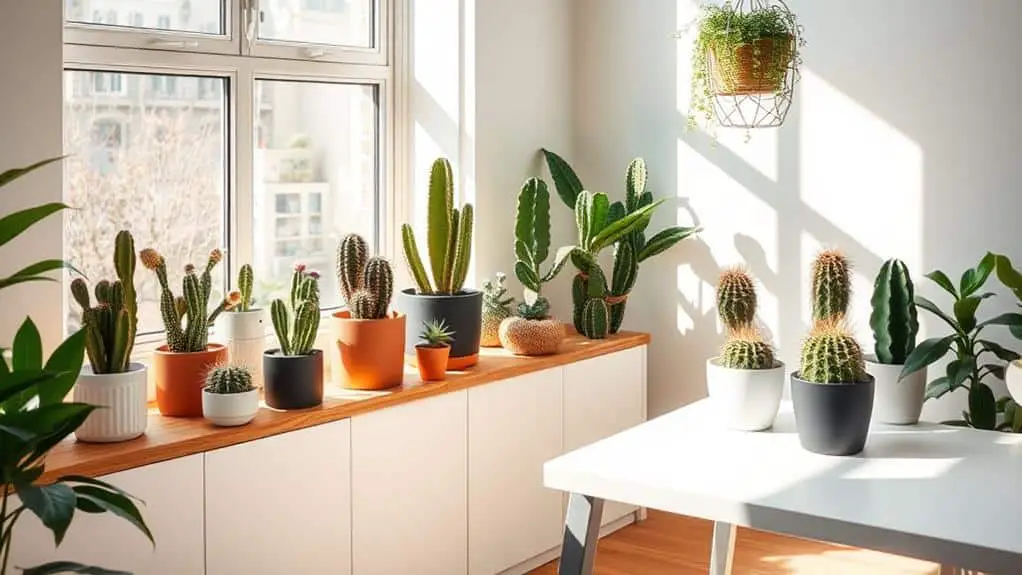
To keep your cactus happy and healthy, make certain it gets at least 6 hours of bright light each day, with 8 hours being even better for growth and flowering.
Place your cactus on a south or west-facing windowsill to maximize light exposure, and remember to rotate the pot regularly to guarantee even lighting.
If natural light isn't enough, use grow lights to provide 10-14 hours of bright light daily for ideal growth.
Optimal Light Placement
Making sure your cacti get the right amount of light is vital for their growth and well-being. Cacti need several hours of bright light daily, ideally between 6 to 8 hours, to thrive.
For ideal light placement, consider putting your indoor cactus on a south or west-facing windowsill. These spots typically receive the most direct sunlight, which is perfect during the growing season.
If your cactus has been in lower light conditions, introduce it to direct sunlight gradually. This helps prevent sunburn, which can harm your plant.
It's also a good idea to rotate your cactus pots regularly. This guarantees even light distribution and stops your cactus from stretching toward the light, a condition known as etiolation.
Keep an eye on your cactus for signs of poor lighting. Discoloration or thinning might mean it's not getting enough light. If you notice these signs, adjust the placement to make sure it gets adequate light.
Supplementing With Grow Lights
Sometimes, natural sunlight just isn't enough to meet your cactus's light needs, especially during shorter days or in less sunny climates. That's when grow lights come in handy. Cacti require 10-14 hours of bright light daily for ideal growth. When natural light falls short, supplementing with grow lights can make all the difference.
Full-spectrum LED grow lights are perfect for indoor cacti. They emit the wavelengths that cacti thrive on, particularly in the blue and red spectrums. Position these lights 6-12 inches above your cactus. This setup provides adequate light without causing heat stress or burning your plant.
As your cacti grow, regularly adjust the height of the grow lights to maintain proper light exposure and prevent etiolation, which is when the cactus stretches towards the light.
Keep an eye out for signs of light deficiency, such as discoloration or thinning. If you notice these symptoms, adjust the duration and intensity of the grow light exposure accordingly.
Water Correctly
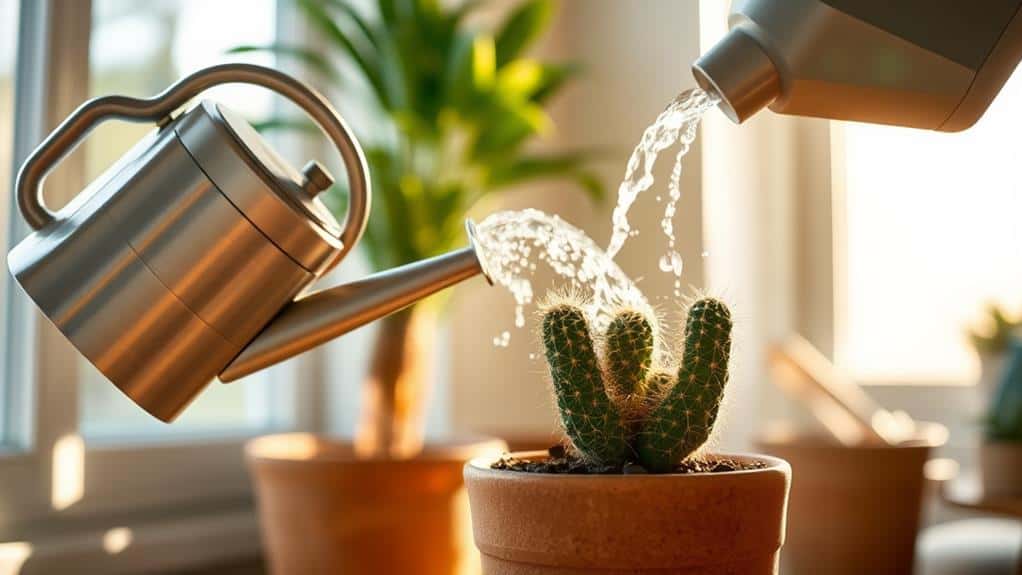
To water your indoor cactus correctly, allow the soil to dry out completely between watering sessions to prevent root rot.
Typically, this means watering every 3-4 weeks in summer and every 4-6 weeks in winter.
Check the soil moisture by using a moisture meter or inserting a wooden chopstick to verify the top 2 inches are dry before you add water.
Timing Between Watering
Mastering the timing between watering your indoor cactus is essential for its health and longevity. Cactus plants thrive in drier conditions and are highly sensitive to excess water. Allow the soil to dry completely before watering again to prevent root rot. Overwatering is a common mistake, so always verify your pots have drainage holes to let water escape.
During the summer months, plan to water your cactus every 3-4 weeks. This is when they're in their active growing phase and may need a bit more water.
In winter, you can extend the interval to every 4-6 weeks. Cacti need less water during this dormant period.
Environmental conditions like temperature and humidity can affect how quickly the soil dries out. It's best to adjust your watering routine accordingly.
Always confirm the top 1-2 inches of soil are dry before adding more water.
Soil Moisture Check
Ensuring your cactus gets the right amount of water hinges on accurately checking soil moisture levels.
Cacti thrive when their soil must dry completely between watering sessions. This usually means letting several weeks pass, with the exact timing depending on the season and your home's conditions.
To check if your cactus needs water, you can use a moisture meter or a simple wooden chopstick. Insert it into the soil and pull it out to see if it feels dry. If it does, it's time to water. If it's still damp, wait a bit longer.
During the growing season, from spring to summer, you'll likely need to water your cactus every 3-4 weeks. In winter, you can extend this to every 4-6 weeks.
Use Proper Soil
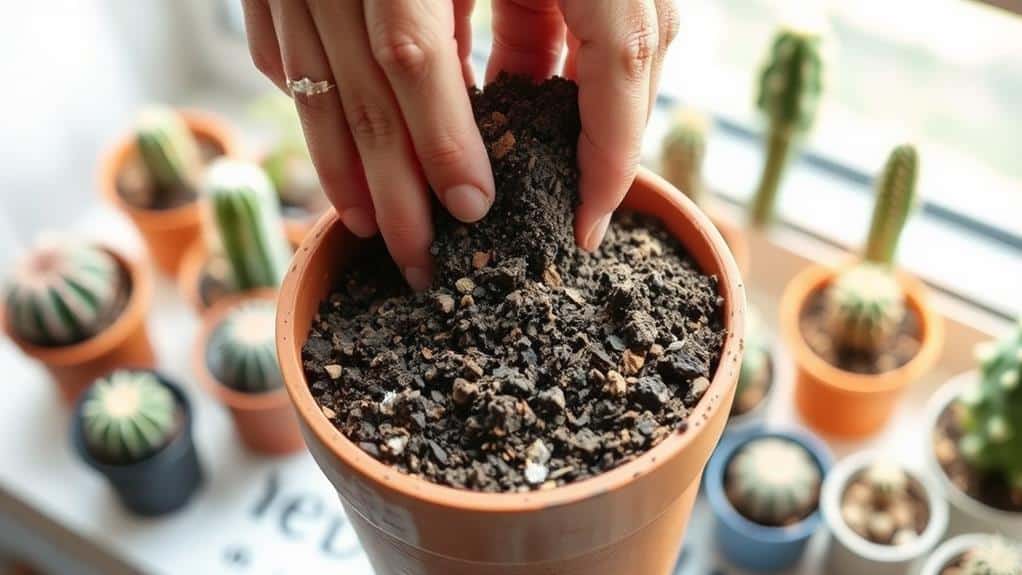
When growing cactus indoors, choosing the right soil mix is vital for their health and growth. Cacti need a fast-draining, porous soil mix to thrive. Ideally, you want a blend that's 50% organic materials, like potting soil, and 50% inorganic components, such as pumice or coarse sand. This combination helps enhance drainage and minimizes water retention, which is essential for healthy root growth.
You can easily find specialized cactus soil at nurseries, but making your own mix isn't hard. When repotting, make certain the pot size suits your cactus type. For vertical cacti, use shallow pots that are about half the height of the plant for stability. For spreading varieties, choose pots that are two inches larger than the cactus itself.
Always pick pots with drainage holes. These holes let excess water escape, reducing the risk of root rot—a common problem for cacti in poorly drained soil.
Repotting should be done every five years, and only move to a larger pot if the roots need more space. Following these steps guarantees your cactus stays healthy and continues to grow beautifully indoors.
Fertilize Sparingly
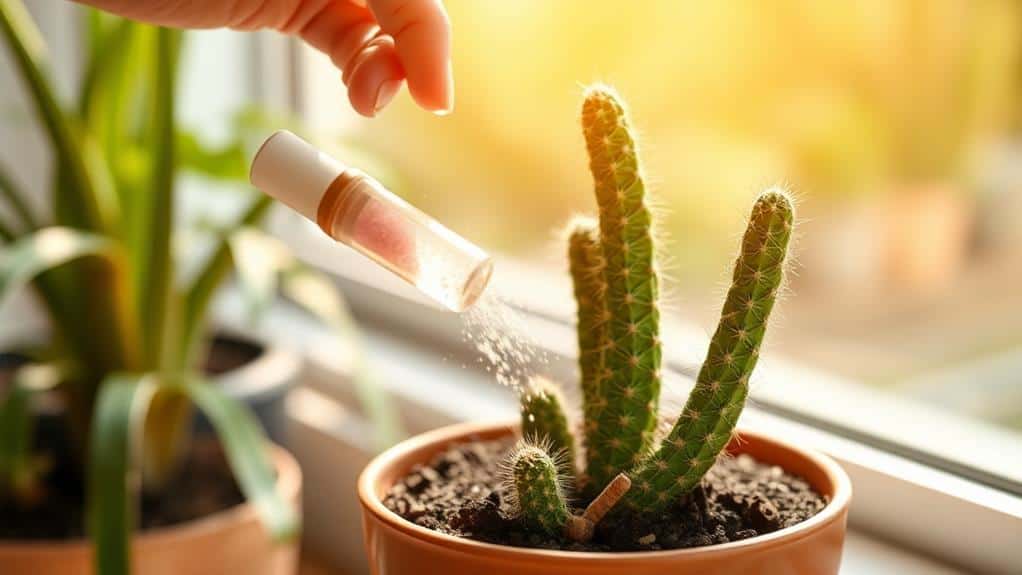
During the growing season, it's vital to fertilize indoor cacti sparingly to maintain their health. Fertilizing your cacti 2-3 times a year during late spring and summer can provide the necessary nutrients for growth and flowering.
Use a balanced plant food, like Maxsea All-Purpose (16-16-16) or Foxfarm Grow Big (6-4-4), but be certain to dilute it to half strength. This helps avoid nutrient overload, which can harm your cacti.
Remember, cacti need a lot of light, water, and a well-draining soil mix to thrive. Over-fertilizing, especially with poor drainage, can lead to root rot and other issues.
When you fertilize, make certain the soil is light and well-draining to support healthy growth. Monitor your cacti's health closely; too much fertilizer can cause weak, spindly growth, making them more susceptible to pests.
During fall and winter, when cacti enter dormancy, you should withhold fertilization. They don't need extra nutrients during this time, as they're not actively growing.
Monitor for Pests

Keeping a close eye on your indoor cacti for pests is essential to maintaining their health. Regularly inspect your cactus for signs of pests like mealybugs, scale, and spider mites. These tiny invaders can cause significant damage if you don't catch them early. Look for discolored spots, webbing, or sticky residue on your plant.
To help you monitor effectively, here's a quick guide:
| Pest Type | Signs | Action | Prevention |
|---|---|---|---|
| Mealybugs | White, cottony spots | Rinse with water | Keep area clean |
| Scale | Brown, shell-like bumps | Mist or rinse | Monitor regularly |
| Spider Mites | Fine webbing, yellowing | Rinse thoroughly | Avoid overwatering |
| Aphids | Sticky residue, deformities | Rinse or wipe off | Isolate affected plants |
Overwatering can attract pests and lead to root rot. Monitor for signs like yellowing or wilting, which indicate your plant might be getting too much water. Remember, a clean environment around your cactus can deter pests. If a pest issue becomes severe, isolate the affected cactus to protect the rest of your collection. By staying vigilant and taking prompt action, you'll keep your cacti healthy and thriving.
Ensure Pet Safety

Ensuring pet safety around indoor cacti is essential, considering the potential risks their spines pose. Although cacti are classified as non-toxic by the ASPCA, their spines can still harm your curious pets. You need to place your cacti strategically to keep them out of reach and prevent any accidents.
Start by choosing higher shelves or hanging planters for your cacti. This keeps the plants away from your pets' reach and reduces the risk of them getting poked by the spines. If you have particularly curious pets, consider placing the cacti in rooms they don't frequent as much.
Monitoring interactions between your pets and cacti is also vital. Regularly check to see if your pets show any interest in the plants. If they do, you might need to relocate the cacti to a safer spot.
Even though cacti are non-toxic, consuming them can still be harmful and might indicate underlying health issues in your pets.
Frequently Asked Questions
How to Take Care of Cactus Indoors for Beginners?
To care for an indoor cactus, place it in bright light, water sparingly, use well-draining soil, fertilize during the growing season, and monitor for pests. Always let the soil dry completely between watering sessions to prevent root rot.
How Do Cactus Grow for Beginners?
You'll find cacti grow slowly, needing patience. Make certain they get 6 hours of bright light daily. Water them sparingly, letting soil dry out completely. Fertilize sparingly and repot every 5 years with well-draining soil.
What Is the Easiest Cactus to Grow Inside?
The easiest cactus to grow inside is the Blue Candle cactus. It's resilient and thrives in lower light conditions. You'll find it low-maintenance and perfect for beginners wanting an easy, attractive indoor plant.
How Do You Plant Cactus Step by Step?
You'll start by choosing healthy cactus cuttings, letting them heal for two days. Plant them in well-draining soil, mist lightly, and position in bright, indirect light. Avoid watering for two weeks to guarantee proper root establishment.
Conclusion
You've got everything you need to grow a healthy cactus indoors. By picking the right variety, giving it plenty of light, and watering properly, you'll set your cactus up for success. Don't forget the fast-draining soil and sparing fertilizer. Keep an eye out for pests and make sure your cactus is safe from pets. With these steps, you'll enjoy a thriving cactus in no time. Happy gardening, and remember, you've got this!

